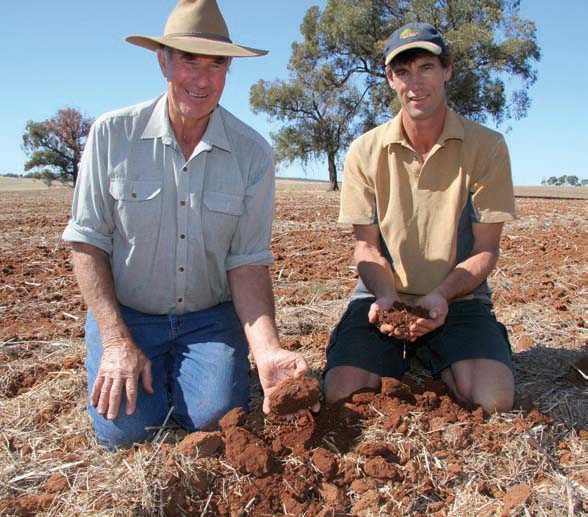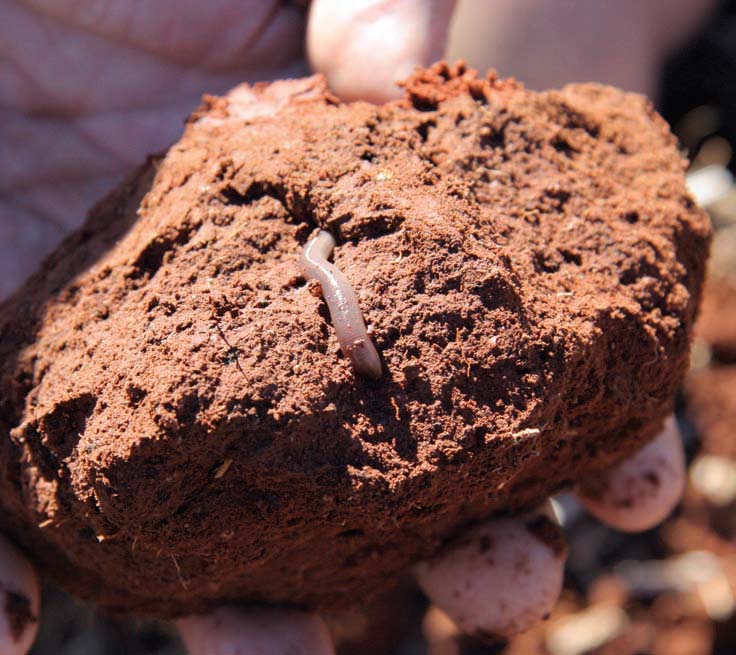
Case
Study
Location
Manildra, New South Wales
Crop
Mixed farming
Watts Family, ‘Pinevale’ Manildra NSW
A biological soil nutrient program has dramatically improved the productivity and general well-being of a mixed farming enterprise operated by the Watts family in Central West NSW.
Charlie and Jenny Watts, together with their son and daughter-in-law, Andrew and Tina Watts, run 1,100 first-cross ewes and 40 Angus x Santa Gertrudis crossbred cows, as well as growing up to 200 ha of winter cereals and oilseeds on their 890 ha Manildra-district property, ‘Pinevale’.
According to Charlie, the enterprise faced a major crossroads about a decade ago. Their wool enterprise was becoming unviable, yet increased emphasis on cropping seemed unfeasible due to a number of soil and weed problems. The ‘crunch’ came when they lost a cow and calf to magnesium deficiency, even after implementing a conventional fertiliser program to correct this problem. “That really made us start thinking – we knew there was something wrong somewhere,” Charlie said.
They had only to look over the boundary fence to see the contrast between the health of their crops and pastures and those grown by their neighbours, Andrew and Rhonda Watt, who, at the time, were the local agents for BioAg.

Charlie and Andrew Watts of ‘Pinevale’, Manildra NSW.

Earthworms are abundant in the fertile soils of ‘Pinevale’.
One of BioAg’s key products is BioAgPhos®, a reactive phosphate rock that has been treated with a proprietary microbial culture. About half of the 13 percent phosphorus content is available immediately for plant use, while the remainder is slowly digested by the microorganisms and added to the nutrient reservoir in the soil.
The improved soil microbial activity is also claimed to help unlock phosphorus, calcium and sulphur already in the soil, leading to long-term benefits in soil structure and fertility. BioAg also markets a range of fermented liquid cultures which deliver essential nutrients and metabolites directly to pastures and crops, as well as stimulating microbial activity in the soil.
Charlie decided to investigate further and invited Andrew Watt to carry out soil tests and tailor-make a soil fertility program for the ‘Pinevale’ cropping program in 1999. In a typical year, they plant about 40 ha of canola, 40 ha of grazing wheat, 80 ha of grazing triticale and up to 40 ha of lupins. After a two or three year cropping phase, the paddocks are sown to phalaris, ryegrass and clover based pastures.
Each cropping paddock now receives 125kg per ha of BioAgPhos, 270kg per ha of lime, 120kg per ha of sulphate of ammonia and 5.5kg per ha of magnesium sulphate, as well as smaller amounts of vitamins and other additives, during autumn. At sowing, each paddock gets 17-30kg per ha of monoammonium phosphate (MAP) and 2-3L per ha of BioAg Soil & Seed™, a liquid treatment that encourages rapid germination, root development and soil microbial activity, mixed with either glyphosate or trifluralin to control annual ryegrass and wire weed.
After they have been grazed, the cereals receive 1.5L per ha of BioAg Balance & Grow®, a foliar treatment which stimulates vegetative growth and improves soil microbial activity, mixed with small amounts of urea or calcium nitrate. Wheat and canola crops also receive 1.6L per ha of BioAg Fruit & Balance™, a foliar treatment which delivers a rich source of nutrients to enhance yield and quality. This is mixed with 4-6kg per ha of urea and applied at flowering to the canola crops and after head emergence in the wheat crops.
“The improved soil microbial activity is also claimed to help unlock phosphorus, calcium and sulphur already in the soil, leading to long-term benefits in soil structure and fertility.”
Charlie said his crops were now yielding higher than the district average, while the wheat averaged 12.6 percent protein last year. “We get a lot more feed off them and they recover much faster after grazing,” he said. “Even though we’ve had a run of dry seasons, we are still grazing our dual-purpose crops and reaching our yield targets of about four tonnes per ha. Last year, we grew 100 tonnes of canola that had a 43 percent oil content from a 40 ha paddock that wasn’t sown till the end of June. We’re using a lot less fertiliser than before. We’re putting on about 12kg per ha of urea, whereas before we’d be using 80kg per ha. At $620 a tonne that’s quite a saving.
Overall, our crops seem much healthier and we’re feeling a lot happier, more secure and sustainable. Farming is much more interesting – we’re always looking at other farms and learning.”
Charlie and Andrew have also noticed a significant improvement in the ‘softness’ of the property’s red clay to sandy loam soils. “Our soils make better use of the average 600mm rainfall and they seem to be full of earthworms, which aerate the ground and fertilise it with their castings,” he said. “The soil is also easier to work with machinery, reducing fuel bills and point wear. The living microbes in the soil create warmth. The soil is warmer, even in winter, seeds germinate quicker and everything stays greener for longer. We’re among the first to plant and last to harvest.”
Completing the biological cycle, stubble is sprayed with BioAg Digest-it® for Stubble, a liquid microbial culture that accelerates the decomposition of crop resides into plant-available nutrients and helps to improve soil microbial activity. Charlie avoids the use of insecticides or fungicides wherever possible, preferring to let beneficial predatory species, such as lady beetles and spiders, take care of insect pests. “If you spray for Redlegged earth mites, you’ll kill the beneficial species as well,” he said.
The Watts family had already been nudged in a biological direction when students from Hawkesbury Agricultural College spread strips of humus made from garden and forestry waste in a paddock. Ten years later, Charlie still takes pleasure in pointing out the improvements the humus made to the soil.
Download case study
Download a PDF version of the above case study.

Recent Comments